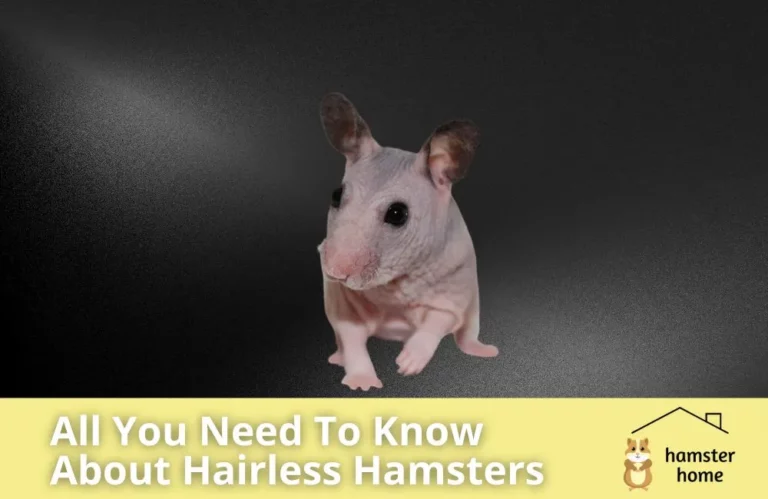What are hairless hamsters? – Hairless hamsters are Syrian hamsters, but without hair. The absence of hair in this unique breed of Syrian hamsters makes them a perfect choice for allergic people who want to keep hamsters as pets. This breed was first seen in China in the 1980s but is now common worldwide.
Now, you know that hairless hamsters are a rare breed of Syrian hamsters that are getting popularity in recent years. Being a unique breed, you’ll not find enough data on how to keep a hairless hamster as a pet. You’ll find everything about hairless hamsters, including their behavior, diet, care, and health problems, in this post.
How Do Hairless Hamsters Look?
One of the reasons for the increasing popularity of hairless hamsters is the way they look. In the case of hairless hamsters, the color of the fur doesn’t matter as this unique breed of Syrian hamsters doesn’t have fur. Brown, black and white is the typical colors of hairless hamsters. You can choose any color as per your choice.
Hairless Hamsters Personality and Behaviour
When it comes to the personality and behavior of these hamsters, you’ll be at ease. Hairless hamsters won’t give you a tough time doing things that might be aggressive or irritating to you.
For example, hairless hamsters are considered nocturnal animals and won’t disturb your sleep at night. They mostly sleep during the day and are active at night but busy themselves. They won’t come near you when you’re sleeping, allowing you to sleep peacefully.
Hairless hamsters can’t be kept in the same cage as furred hamsters due to their aggressive nature. However, they are happy when they are kept with hairless hamsters. Hairless hamsters are rare, so their behavior isn’t studied well yet. However, it seems that they like to chew things like wires.
Hairless Hamsters Diet: What They Can Eat and What Not?
Hairless hamsters are omnivores and can eat both plants based and animal-based foods. However, you have to provide exceptional care to hairless hamsters regarding their diet. They don’t have fur, so their body requirements are different from other hamster breeds. So, hairless hamsters need a different diet as well to cope with the environmental challenges.
You can give fruits, vegetables, seeds, etc. Due to the lack of skin, hairless hamsters need more food per day and nutrients than other hamsters. You have to add more proteins to their diet, so they can keep themselves warm, especially during the winter months.
Hairless hamsters have a slow metabolism due to the absence of fur. You have to feed them more, so their body can digest some proportion of each meal to provide them with the required calories.
While feeding hairless hamsters, you have to be careful about adding sugar or salt to their diet. Too much sugar and salt are harmful to the hairless hamster’s kidneys and make them diabetic. So, it’s better to avoid such items in your hairless hamster’s diet.
What’s The Average Lifespan of Hairless Hamsters?
The average lifespan of hairless hamsters is the same as that of the Syrian hamsters, which is 2-3 years. When a hairless hamster turns one year old, he is considered old and needs special care to extend his lifespan.
Also, they have weak immune systems, which make them prone to many diseases. Different health issues can shorten the lifespan of your hairless hamsters.
Some things that you can do to extend the lifespan of your hairless hamsters are mentioned below:
- Give them tools such as an exercise wheel to ensure that they can remain physically active. Without the required physical activity, hairless hamsters can gain weight quickly, increasing the risk of diabetes.
- The environment should be safe for your hamster. Keep them away from predators and other things that can harm them.
- Don’t compromise on the diet of your hairless hamster. Provide him with a balanced diet that should contain all the essential nutrients in a balanced amount.
By doing these simple things, you can keep your little hairless hamster safe and healthy, which will extend his lifespan.
How Much Do Hairless Hamsters Cost?
Hairless hamsters’ costs can be anywhere between $25 to $150. The price varies depending upon the color and origin of the hairless hamsters. Unlike other types of hamsters, the cost of hairless hamsters varies a lot because there are not many breeders who produce and sell them.
Therefore, it’s essential to make a good time to search the breeders to get one at an economical rate.
Hairless Hamsters Care Guide
As a responsible pet owner, you should understand how to care for your little hamster. He won’t be able to put his needs and problems in words, so it’s up to you to understand everything to save your pet from suffering. Hairless hamsters’ care is slightly different from the other breeds, and they are not easy to care breed.
They need extensive care to survive in the household. Here are some tips that can help you in caring for your hairless hamster:
- Give a lot of food to your hairless hamster. They shouldn’t be given food that you would give to other Syrian hamsters. Due to their slower metabolism, they need more food than other hamsters.
- Hairless hamsters don’t have fur to protect themselves from UV radiation. To keep your hairless hamster safe, reduce the sun time as much as possible. Excessive exposure to the sun can lead to the development of many skin problems in your hairless hamster.
- The absence of fur makes them less resistant to cold and warm temperatures. You should adjust the temperature to a safe range if you don’t want your furry buddy to suffer due to temperature changes. Moreover, you have to ensure that your hairless hamster doesn’t face frequent temperature changes. It will be hard for your hamster to regulate its body temperature, and death can occur in such cases.
- It’s better not to consider rough beddings, such as wood shavings or sawdust, for hairless hamsters. They don’t have fur for protecting their skin and can thus get injured easily.
Common Health Issues of Hairless Hamsters
Hairless hamsters are different from other hamsters. They suffer from health problems that other hamsters usually don’t get. Some common health issues of hairless hamsters are:
Diabetes
Hairless hamsters can get diabetes more quickly than other types of hamsters. The risk of diabetes can be reduced by checking hairless hamsters’ sugar levels frequently. If the sugar levels aren’t normal, you can bring them back to normal by changes in diet and prescribed medications.
Skin Diseases
Hairless hamsters suffer the harmful effects of UV radiation more than other breeds of hamsters. Common skin disease of hairless hamsters is sunburn. In severe cases, blistering can also occur. You can keep your hamster covered when facing the sun for more extended periods. Otherwise, it’s better to keep them indoors to avoid skin diseases.
Body Temperature Regulation
Hairless hamsters can catch a cold quickly or find it hard to adjust their body temperature. If you want to keep a hairless hamster, you must ensure that they are not exposed to extreme temperature changes.
FAQs
Purchasing hairless hamsters isn’t considered ethical because they aren’t commonly found in the wild. They are produced due to a mutation and are more susceptible to common health issues than other hamster breeds. They can quickly get diabetes which is a significant health hazard for these little creatures. Therefore, you should prefer other hamster breeds as pets over hairless hamsters.
No, breeding hairless hamsters isn’t an easy thing to do. They are produced due to mutation, and female hairless hamsters are not known as good breeders. They don’t lactate enough for the newborn hamsters. Therefore, it’s not easy to breed hairless hamsters yourself without the help of professional breeders.
No, hairless hamsters aren’t often recommended for first-time hamster owners. They have shorter lifespans and weaker immune systems. You have to make time for their regular vet appointments for different health issues that may arise. As a first-time hamster owner, you won’t be able to manage caring for them with other things. So, it’s better not to have them if you don’t have any experience in keeping hamsters.
Hairless Hamsters Wrapped Up
Hairless hamsters are a rare breed of Syrian hamsters that lack fur. They are available in different colors, and their appearance is the primary reason for their popularity. Hairless hamsters are omnivores, so they can eat anything unless it contains too much salt and sugar.
They can live for at least 2-3 years if good care is ensured. You have to keep this breed safe from sharp and rough objects because they can get hurt easily due to the lack of fur. Many diseases can affect hairless hamsters, such as diabetes, sunburn, blistering, etc. Proper care and vet consultation are the ways to keep hairless hamsters healthy, even if you have never kept a hamster before!







